Bonefish: The Retrieve, Hookup, and Fight
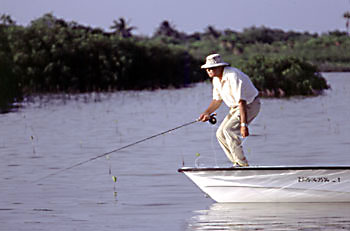
Try to read the bone's reaction to the fly. If you understand it, his body language will tell you what to do. Photo by Markus Haugg.
THE FLY LANDED in the right place. You let the small shrimp imitation sink to the proper level, and the bonefish seems to have noticed it. It’s time to start acting like a shrimp. You begin a series of very short strips, trying to make the fly imitate the slow progress of a small shrimp that hasn’t yet spotted the predator closing in on it. But the bonefish loses interest and turns away as if he never saw the fly.
What happened? My guess is that the fly never moved.
In trying to impart action to a fly, you must think of several factors besides the movements of your line hand. If you have any slack in the line while trying to give life to the fly, the movements of your line hand will only take up some of the slack. The fly, meanwhile, is sitting still; you think that you are moving it, but you’re not. By the time you take up all the slack and the fly finally starts to move, the bonefish is long gone.
Slack has several causes. Even if you cast well, the fly line is not perfectly straight at the end of the cast. As soon as the line falls to the water, wind and waves start to push even more slack into it. The boat might be moving toward the fish. If you start the retrieve with the tip of the rod high above the water, you will create a big belly of slack that absorbs every movement of your line hand.
Get ready to impart action to the fly by lowering the tip all the way to the water if possible. All the way — touch the tip-top to the surface. If you are standing too high on the skiff to touch the water with the rod, at least get the tip as close as possible to the surface. Then strip until the fly line is nice and straight. You’ll find that now the slightest movement of your line hand will cause a nearly equal movement of the fly. With no slack, you’ll be able to feel the slightest, most subtle strike, and you will miss fewer fish.
Now you can make that shrimp walk and talk. Instead of turning and swimming away, the bonefish will respond to the fly.
Shallow Water
Let the fly sink when you fish in water less than a foot deep, but not necessarily to the bottom. In very shallow water, bonefish often take a fly as it sinks, particularly when it gets close to the sand or grass.
If the fish doesn’t react, maybe he hasn’t yet seen the fly. Give it a bump or two. Just as a blinking light draws more attention than a light that’s not blinking, a fly that twitches or darts catches the fish’s attention. Be gentle with these bumps; a violent, jerky movement can scare the fish.
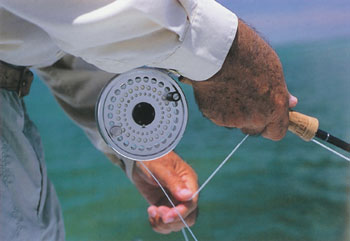
Even when you are not actively retrieving, make sure you are "tight" to the fly — that is, no slack. Photo by Stephen Fernandez.
If he follows the fly without taking it, move the fly slowly and steadily-no bumps or jerks. Make long, slow strips. This type of retrieve might not seem very active, but the fly’s materials wiggle and pulse as the pattern travels through the water.
Remember to fish slowly. Many of the foods consumed by bonefish, particularly crustaceans, move slowly and often awkwardly. Just as a man can’t take a thirty-foot stride, a one- or two-inch shrimp cannot take a quick two-foot stride. It would look unnatural to the bonefish.
You have to become the food that your fly imitates so that the impostor, the fly, will play a convincing role. You are an actor imitating a shrimp or a baitfish. Become the food.
Because it is mostly white with some yellow in the belly, my Bonefish Special is meant to imitate a small schoolmaster snapper or yellowfin shad. At least I feel that it does; I don’t know what the bonefish thinks, of course. As I strip a Bonefish Special, I am that small baitfish — until the bonefish takes it and the ruse is over. Then Chico the angler strikes back.
If a bonefish is within a few feet of the fly, you might want to leave it on the bottom for a few seconds before you move it, especially if it’s a shrimp or crab imitation. Don’t be in a rush to move the fly. It is not unusual to see a bonefish come from six feet away to pick up a fly sitting on the bottom.
Deeper Water
Shallow-water fishing is very exciting, but don’t underestimate sight-casting in more than two feet of water. If anything, seeing and casting to bonefish in slightly deeper water is even more challenging than fishing on a very shallow flat. Besides, deeper flats often hold bigger bonefish.
When you fish in deeper water, make the presentation with a longer lead that gives the fly time to sink to the bottom or very close to it. Even though you generally use a slightly heavier fly than you would in skinny water, it still takes a bit longer to reach bottom. Don’t start the retrieve too early.
It’s important to develop a feel for how quickly (or slowly) a fly sinks. Before you start hunting, simply drop the fly in front of you and see how long it takes to reach bottom. You can count if you like — one-one-thousand, two-one-thousand, and so on. I do this with all flies, and I really think it helps. Remember that you want to stay at the fish’s level or below, because practically all of his prey tries to hide in or on the bottom. Prey does not try to outrun a bonefish; it knows that it can’t.
Since a fly for deeper water is usually larger than a skinny-water pattern, it probably imitates something that swims a bit faster. In deep water, I tend to use a faster, more aggressive retrieve.
Mudding Fish in Deeper Water
Although a mud gives me a pretty good idea where the fish are, I still try to spot an individual fish so that I can make the most accurate presentation possible. On a flat deeper than two feet, I try to determine the fish’s level in the water instead of letting the fly drop all the way to the bottom; with all that mud around him, a bonefish might not see a fly sitting on the bottom of the flat. When the fish rushes the fly, I watch for the sudden stop that tells me he’s got it.
As a rule, I fish minnow flies the fastest, though still not as fast as I’d retrieve a streamer for most other species. I fish crab flies the slowest, giving them little movement and keeping them on the bottom more than other patterns.
Even in deeper water, it’s still important to match the retrieve to the mood and behavior of the fish. I move the fly a bit faster for a fish that’s feeding quickly, and slower for a tailing fish that’s making very little forward progress.
Remember never to work a fly toward a fish, no matter how deep the water is. They are not used to being attacked by their food. Even though the fly is so much smaller than the bonefish, it can still frighten him. The food should always look like it’s trying to get away from the predator.
If a fish merely follows the fly, looking curious but passive, try changing speeds. Either accelerate your retrieve to make the prey look like it’s fleeing, or stop and let the fly drop to the bottom as if it’s trying to hide under the sand or grass. If changing speeds doesn’t work, and especially if two or three fish in a row refuse to bite, consider changing flies. I can’t tell you which fly the bones will want, but I have learned that changing size is usually more important than changing color.
Capt. Steve Huff fishes for bones almost exclusively with crab flies and shrimp patterns such as his Joe-to-Go, and he’s among the great masters at reading the fish’s attitude. “I try to get a recognition in the fish’s behavior that he has seen or is aware of the fly,” Steve says. “Then, if he is very close to the fly, say a fish length away, I may not move it. If he is a couple of fish lengths away, I may twitch it or move it slowly again, just trying to make sure I got his attention.” That’s good advice, and it underscores the importance of making sure that the bonefish has spotted the fly. If you know that he has seen it, then you can alter your retrieve — speed it up, let the fly drop, or swim the fly slowly and steadily — to make the fish bite. If you’re certain that several fish have seen the fly, and if changing the retrieve failed to convince them, then think about trying another fly.
Learn From Rejection
Always take time to talk with your guide and discuss what happened with every fish. Guides are no different from other people; some are more outgoing than others. Very often, a guide who doesn’t say much will, when asked, explain that the fly was just behind the fish, that the cast was great but the fish was already a bit nervous, or whatever. You will learn with every mistake and every opportunity. That’s how you get better.
I have seen anglers spend several days missing fish, only to find out that the guide knew the reason but was just too shy to speak up. At the end of the last day, the guide finally says, “The fly wasn’t sinking fast enough” or, “You need to lead them a little more when they are that spooky.” No doubt it’s good advice — but it comes too late to do the angler any good on this trip.
Don’t assume that your guide has nothing to say. Maybe he’s just shy. Ask for guidance and advice. I do all the time.
Many fish hit a fly hard, or at least grab it with a solid pull, but the take of a bonefish can be subtle. Very often, you don’t feel the take at all. Your only indication of the strike is the fish’s body language.
If a bonefish comes from the side and takes the fly hard, you will probably feel him. No problem here. You are more likely to feel a strike when you are stripping fast, or relatively fast, as you would with a baitfish pattern such as a Clouser Minnow or Bonefish Special. Bonefish usually take crustacean patterns very softly. The fish will come up behind the fly and take it as he is moving forward and toward you. If he is moving faster than your retrieve, which often happens, he is creating slack rather than pulling, and you won’t feel the take. But you have a very short time in which to strike before he decides that the fly is not food and spits it out. To compound your difficulties, in many situations the skiff is drifting toward the fish, creating even more slack. So, how do you know if the fish has the fly?
Usually, you will see the fish following the fly and then rushing toward it and stopping, or stopping and wiggling. He’s trying to eat it or he’s got it-that’s why he stopped. You’ve got to strip-strike now.
You might think that if you keep stripping, sooner or later you are going to tighten up and feel him. After all, the line has only a couple of feet of slack. Most often, though, the fish spits out the fly before you feel him. You will not know that you had a strike.
I’ve often heard a guide tell a client, “He’s got it, he’s got it!” The client stood there puzzled because he didn’t feel anything. And since he wasn’t looking for the fish’s sudden stop, he didn’t see anything, either. I’ve witnessed situations in which a bonefish took a fly two or three times on the same retrieve and the angler never struck once. Meanwhile, the guide and I were going crazy. Fun, isn’t it?
When a fish that’s right on top of your fly stops all of sudden, he’s probably chewing on it. Strike. But even if the fish has the fly in his mouth, you can still miss him by striking the wrong way.
How to Strike
This is one of those situations in which instinct does not help you. When you believe that a bonefish has picked up the fly, your natural reaction is to raise the rod, snapping it up and back. So that’s what you do-and you get the first perfect backcast of the day. The fish, as excited as you are, rushes after the fly and comes face to face with you, a large boat, and a screaming guide with an eighteen-foot stick. Poof — he is gone.
Using the rod to strike a fish has several big drawbacks. For starters, it is too slow. Your rod tip is low to the water during the retrieve. To strike, you lift the rod up; then, when it is high enough, you start to bring the rod back until (you hope) the line comes tight and, eventually, the hook sinks in. It takes an eternity. Believe me, you will be late with the strike. And when you miss, the momentum of your long, sweeping strike yanks the fly out of the water and out of the game. You have ruined your chances with a fish that wanted the fly.
With bigger fish such as tarpon, or with any fish that has a hard mouth, striking with the rod does a poor job of setting the hook. You might feel the fish for a second, but the rod simply doesn’t transmit enough force to drive the hook home.
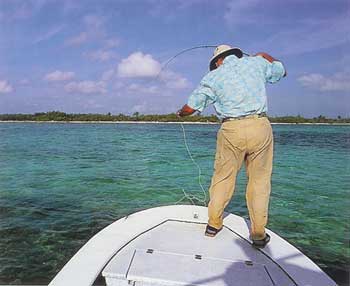
I know it's hard, but don't look at the bonefish as it begins its first run. Look down at the fly line until you've cleared all of it. Photo by Steven Fernandez.
You are much better off using the strip-strike method. This is accomplished by stripping line, much as you do when retrieving a fly, but faster and harder. It’s more like a pull than a strip. It’s also lightning fast. As you strip-strike, you can lift the rod a little, but only a little; nearly all the force of the strike comes from your line hand. Strip-striking is one of the essential skills for flats fishing.
The length of the strip strike varies according to the amount of slack in the line. It may be a foot or a yard. Generally, the strip is shorter if you felt the fish pick up the fly, and a bit longer if you detected the bite only by the fish’s body movement or were directed to strike by your guide.
Because you are pulling straight back with the line and without using the rod, this method produces a lot of force. Without much effort at all, you will easily drive the small hook into the bonefish’s mouth. When you try to set the hook with the rod, the fish has all the advantage of the 9-foot lever in your hand. With a strip strike, you’re pulling directly on the hook.
The strip-strike method has another great advantage if you miss. Unlike striking and missing with the rod, which yanks the fly many yards away from the fish, strip-striking moves the fly only a foot or two. The movement even looks natural, like that of a shrimp or minnow darting for cover, and it’s unlikely to spook the bonefish. You are still in the game. Quite often, the bonefish will rush the fly and grab it again. If the fish doesn’t charge immediately, resume the retrieve.
Sometimes a bonefish loses interest in the fly-or simply loses sight of it-after you strip-strike and miss. He’s not spooked; indeed, he’s still looking for food. Let him swim a few feet, maybe a few yards, and then quietly slide the line off the water to make another cast. This presentation should be easy. You have practically all the line you need outside the tip of the rod, and the bonefish is roughly the same distance from you. Since you don’t have to shoot a lot of line, you should have no trouble making a very accurate second presentation.
Planting the hook in the fish’s mouth does not complete the strike. Once you have made the strip-strike and felt a solid hookup, you need some cushion so that you don’t break the tippet. After all, at the instant of the strike, you have a straight, tight line between you and the fish. Lift the rod to about a 45-degree angle as soon as you set the hook. The rod will bend a little, and that bend provides the cushion you need when the fish figures out that something is terribly wrong with the shrimp he just ate.
A good angler strip-strikes, sets the hook, and lifts the rod in a smooth, continuous movement. The entire event takes part of a second. It’s the only way to strike a saltwater fish.
Clearing Line
Congratulations. The fish found the retrieve satisfactory, you executed a perfect strip-strike and instantly raised the rod to 45 degrees, and now you have a hooked bonefish at the end of your tippet. A hooked bone may or may not react immediately to the pressure of the hook; sometimes a fish responds with a few seconds of surprise and confusion. Within no more than a few seconds, however, that fish will begin a very fast run away from the flat and toward the deepest water he can find.
Meanwhile, you have a lot of loose fly line at your feet. If the fish followed the fly for a good distance before making up his mind, you might have a great deal of loose line on the deck. When the fish starts his run-and even a very confused bonefish will have started by the time your heart has beat twice-all that loose line has to go through the rod guides without tangling, without catching on one of your feet, without wrapping about the rod’s fighting butt. Getting the loose fly line off the deck, through the guides, and out of the tip-top without a mishap is called clearing the line.
To clear the fly line at your feet as the bonefish takes off at high speed, you must again do something that is not intuitive: you must take your eyes off the fish and look at your feet. I know it’s hard to do. You want to look at the bonefish you just hooked, but it is essential that you don’t.
Separate your hands. Your rod hand should keep the fighting butt against your wrist so that the line cannot loop around the butt, which is a very common way to break off a running bonefish. Don’t keep the angle of the rod too high while clearing line. Too high an angle tends to make the rod throb back and forth. This movement makes it harder to clear line smoothly and creates slack that allows the fish to slip the hook. Hold the rod at a lower angle and keep it steady as you feed line out.
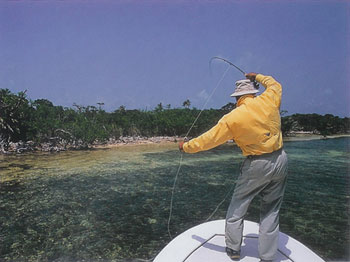
Sometimes a bone will not run right away. While he's making up his mind, make sure that you do not give him any slack. Photo by Stephen Fernandez.
Your line hand should be lower than your rod hand. Apply almost no pressure as the line flies out through the guides — maintain just enough tension so that the line isn’t running loose. This slight pressure gives you control. But don’t hold the line too tightly. If you do, two things will happen, neither of them good. A tightly held fly line can burn your hand, and it will come through your hand in a series of sharp, erratic jerks, bouncing the rod, creating slack, and making the loose line still in the boat jump all over the place until it tangles on something.
I have heard of anglers who make an ‘O’ with the thumb and index finger and let the fly line run freely through that hole. In my experience, a completely loose line will create more tangles than a lightly held line during the clearing process.
Once the fish has taken all but a yard or two of the loose line, you might think that you can relax and let go of the last little bit. You figure a few feet of fly line can’t get caught on anything-it’s too short. Big mistake. If you let go of the last portion of fast-clearing fly line, chances are good that that little loop of line will wrap around the first stripping guide. When that happens, the least disastrous outcome is a broken tippet. Many fish are lost this way. The biggest permit that I have ever hooked, a fish that probably weighed over 40 pounds, was lost to this mistake. It happened a long time ago, but I still remember that fish and the sick feeling I had as the last bit of loose fly line made a neat half-hitch around the stripping guide.
Keep control of the fly line as the fish begins his run. Maintain light pressure on it, watch the line at your feet, and as the last of the loose fly line comes off the deck, follow it with your hand toward the stripping guide and watch it disappear. You are not through clearing line until the reel starts to sing.
The Baffled Bonefish
From time to time you’ll hook a bonefish that does not run, at least right away. He may keep coming your way or swim around in circles or do something else other than make the classic run away from you. But you still have a lot of line to clear.
I generally keep stripping line as he approaches the boat or circles around, but I make sure that I keep a tight line with absolutely no slack. I monitor the fly line at my feet, untangle anything that needs it, and basically get ready for the long run that is coming. And believe me, it’s coming.
Sooner or later, the fish get his wits about him, heads for deep water as he should, and things go back to normal. Just remember not to give him any slack while he’s swimming around in confusion.
Sustaining the Long Run
“Keep the rod high!” was the usual advice years ago, and some anglers still live by it. You were supposed to raise both your hands well over your head with the fly rod way up high. The idea was that you would keep the fly line away from sea fans, coral, and other obstructions, but this generally is not true. Besides, to hold a fly rod so high while a fish makes a long run takes a lot of effort. And it’s an unnecessary effort; it does nothing for you.
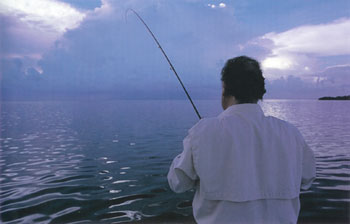
After the long run, be sure to keep a tight line. A large-arbor reel helps a lot in this situation. Photo by Steven Fernandez.
Lifting the tip of the rod as high as you can will raise only a few extra feet of fly line off the water. The rest of the line remains on the surface. You accomplish nothing by lifting the rod over your head, except to make yourself very tired.
Better to keep the fighting butt near your belt and the rod at an angle of 45 degrees or so, and let him run. There’s nothing else to do for the time being. Enjoy your fish-this astonishing run is the reason you traveled thousands of miles to stand on a small boat under a blazing sun.
The one exception is when you hook a bonefish on a flat with small mangrove shoots. You may be able to clear some of these shoots by raising the rod, but only if they are very close to you. Lifting the rod is not going to help you clear a mangrove shoot 30 yards away.
As a fish runs, the diameter of the line remaining on the spool shrinks. That reduced diameter amounts to a shorter lever arm against the resistance of the reel’s brake, which means that drag pressure increases as a fish takes line. How much the drag increases depends on the design and proportions of the reel; a small, wide reel will increase drag pressure considerably as a fish takes line, whereas a large-arbor model maintains more consistent resistance. In any case, you shouldn’t need to adjust the mechanical drag during the first run because you should have started with a relatively light drag. As the fish runs, you can easily apply extra drag with your hands if you feel that you need it. That’s why your reel has an exposed rim on the spool.
If you do feel the drag increasing to the danger point as the fish runs, you started with too much. Back off on the adjustment a little to avoid breaking the tippet or pulling the hook out. Of course, many anglers don’t realize that they had set their drags too tight until it’s too late. Besides, adjusting the drag during a long, fast run is another chance for something to go wrong — what if you turn it the wrong way or loosen it so much that the spool overruns?
Remember to start with a light drag. You need enough to keep the spool from overrunning, but not a great deal more. If you need to put more pressure on the fish, feather the spool.
During the Fight
Eventually, he’ll stop, though there are times when you wonder if he ever will. By then, the fish might be 50 or more than 100 yards away, if he happens to be a large fish. Now the fight begins; you have to regain all that line.
For starters, try to keep a tight line during the fight. A slack line gives the fish a better chance to dislodge the hook. Avoid slack as much as possible.
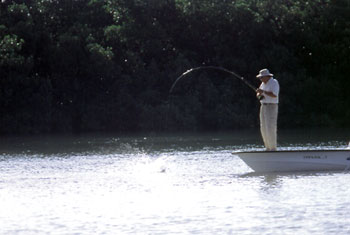
Try to keep a bonefish that is close to the skiff from going under it. Photo by Markus Haugg.
Your next big goal is to get the fly line back inside the rod. This is where you want to fight all fish, if possible. Your guide will pole after the fish as you reel in line (this is one time when you will really appreciate a large-arbor reel). If you’re wading, you could chase the fish to regain line. With a 3-pound bonefish that gets a little into your backing, don’t bother running across the flat-just stand there and enjoy him.
From time to time, a bonefish will start to run back toward you, creating a big belly of slack. Naturally, you must try to retrieve that slack as fast as possible. But do not bring the rod back in an effort to pick up some slack because you’ll be in danger of wrapping the line around the tip of the rod. Instead, keep the rod tip ahead of you. If you want it not to wobble too much as you frantically crank the reel (this, too, can cause a loop of backing to wrap around the rod), keep the tip in the water. This works very well.
Stay as close to the fish as possible during the fight. The closer you are, the more the pressure of your rod will affect him. You’ll simply have more control of events. Ask any experienced tarpon angler.
When a hooked fish manages to tangle some loose grass on the fly line or leader, try to get rid of the grass. You do not want heavy grass hanging from your line during a fight; the strain of dragging a bulky wad of vegetation through the water can break a light bonefish tippet even if your drag is set lightly. To get rid of the grass, lift the fly line as high as you can so that the clinging grass is off the water. Now shake the grass from side to side while it is in the air. With luck, all or most of it should drop off the line.
When a bonefish makes a long run and tangles your line or leader on a mangrove shoot, do not pull. Instead, give him some slack and then carefully approach the fish. As you get closer, you can see how the line is tangled and solve the problem before the fish takes off again. Chances are that the fish will not move much as long as you don’t pull or make a big commotion as you approach him; he is usually tired after that first long run. I have saved many bonefish catches this way.
Toward the end of the fight, when the fish is close to you, keep a low rod angle. Apply pressure against his ever-changing direction of pull-if he pulls to the right, then you pull directly against him to the left, and so forth. By fighting this way, you’ll land him sooner and release him in much better condition, which is what you want.
Once the fish is close to you or the skiff, be prepared for one or two final dashes. The fish might run only a few feet, but he can do it with enough strength to break the tippet if he catches you off guard. Besides, as you bring a bonefish close to the boat, a good part of your long leader comes inside the rod. A sudden lunge by the fish will pull the leader knot back out of the rod, clicking and slamming against every guide. Here again, a low rod angle helps by letting the leader slide freely through the guides. This is also when you find out why it’s good to trim the tag ends of knots as close as possible.
At the end of the fight, a bonefish often pulls one of his most dangerous maneuvers, the “dive under the boat trick.” Many fish break tippets this way, and some break fly rods.
When a fish dives under the skiff, do not keep the rod tip up-this is the worst possible time for high-sticking. The rod bends double and eventually breaks. Don’t try to pull the fish back under the boat when he is already on the other side. Dip the tip of the rod, maybe a foot or more of it if the depth allows, into the water. Make sure that neither the line nor the rod is touching the boat. Then, with the rod tip in the water, move the line around one end of the boat, preferably the bow, and clear the fly line again. Now you are fighting the fish on the other side of the boat, free and clear.
If the boat is drifting toward the fish at the end of the fight, the bonefish will probably run under the skiff. The ideal (though not always possible) arrangement is to have the wind or current moving the boat away from the fish as you fight him.
One last item about pressure. If you are using a size 4 or smaller fly and a 10-pound tippet, remember that excessive pressure can straighten a small hook. A stainless-steel hook is rarely as stiff as a carbon-steel model made of equally thick wire. I’ve straightened a few size 4 and size 6 hooks with 10-pound tippets, but very few with 8-pound tippets. And I never use anything heavier than 10-pound-test material with a size 4 or smaller fly.











